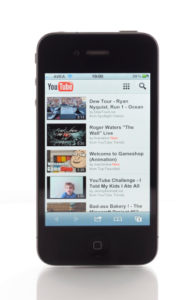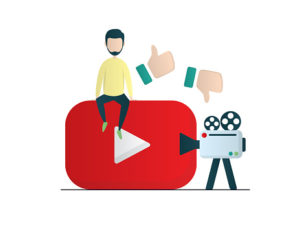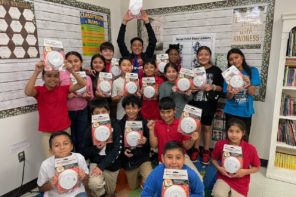Smosh, Good Mythical Morning, Markiplier—these names may not mean much to you, but chances are your kids are on a first-name basis. Their funny hosts, off-the-cuff commentary, silly antics and bewildering (to adults) subject matter put them among the most popular YouTube channels for young teens, garnering millions (and, in the case of game commentary channel PewDiePie, billions) of views.
In fact, according to a survey of U.S. teens by Variety, the top five most influential celebrities are YouTube stars. But information about these personalities’ shows—the content, quality and age-appropriateness, for example—isn’t easy for parents to find.
What Parents Need to Know
Parents need to know that YouTube is a video-sharing site and app, and there are many videos on YouTube that may not be age-appropriate for their kids. The site is entirely user-generated and relies on its community to flag videos that violate YouTube’s terms of service (mostly for sexual content, language and hate speech). Videos here run the gamut, from commercial to educational to music videos to homemade clips.
Many kids love YouTube and rely on it as a way of keeping up with popular culture; videos go “viral” when viewers share the clips they like. YouTube does offer parents the ability to filter out objectionable content and comments using Safety Mode. However, Safety Mode doesn’t catch everything, and it’s easy to disable. YouTube also has three channels by which users can access specialized content: YouTube Kids, YouTube Gaming and YouTube Music. Users can also subscribe to YouTube Premium: For $11.99 a month, users can stream videos for free, save videos for background and offline viewing, and access new original content.
The Download
 YouTube has easily secured its place in pop culture, primarily because it offers so much to discover—and love—in its comprehensive video library: Information. Education. Instruction. Entertainment. Distraction. Delight.
YouTube has easily secured its place in pop culture, primarily because it offers so much to discover—and love—in its comprehensive video library: Information. Education. Instruction. Entertainment. Distraction. Delight.
Want step-by-step guided instructions on making dozens of styles of friendship bracelets? Need to know how to create a unique Halloween costume? Need an idea for dinner or school lunch? Want to show your kid what the robot from Lost in Space looked like or check out the Earth’s solar system? You’ll find that and much, much more here, including the latest viral videos of that kid or cat everyone’s laughing about.
It’s not only a place to experience and enjoy the creativity of others but also a place to exercise your own. The beauty of YouTube is being able to see so much in one place at any given time. But that also makes it difficult to know what your kids are finding and viewing when you’re not supervising.
Try these ideas to help your kids regulate their viewing habits and increase the chances that their experience will be positive.
The Basics
Watch with your kid. Simply ask your kids what they’re watching and join them. In general, kids are tuning into certain channels or following specific YouTube personalities because they’re entertained by them (not because they are actively searching for “bad” stuff ). Many kids naturally want to share the videos they like. But be prepared to watch some weird stuff such as unboxing videos.
Be sleuthy. If you’re concerned about the content your kid is watching on YouTube—and you’ve tried talking to them—there are ways of tracking their viewing habits. If your child has a YouTube account (which only requires a Gmail address), their YouTube page will display their recently-watched videos, recommended videos based on their watch history, and suggestions for channels similar to the ones your child has watched.
Subscribe. Encourage your kids to subscribe to their favorite channels rather than hunting around on YouTube for the latest ones from a specific creator. Subscribers are notified when a new video is uploaded, plus all their channels are displayed in the Subscriptions section, making it easier and faster to go directly to the stuff they like (and that you’ve vetted). Consider choosing subscriptions together, and make an event out of watching the newest uploads with your kids.
The Nitty-Gritty
 Investigate the creator. The name of each video’s creator appears beneath the video window and usually has a bit of information about the person behind the video and/or the channel itself. Google the creator’s name to find out whether they have a Wikipedia page or another Web presence (most YouTubers use other social media including Snapchat, Twitter and Instagram to promote their brand).
Investigate the creator. The name of each video’s creator appears beneath the video window and usually has a bit of information about the person behind the video and/or the channel itself. Google the creator’s name to find out whether they have a Wikipedia page or another Web presence (most YouTubers use other social media including Snapchat, Twitter and Instagram to promote their brand).
Look at the suggestions. The suggested videos listed on the right-hand side of the page are related in some way to the main video. Evaluate them to see if they seem age-appropriate, and that will provide an indication of the appropriateness of the main video.
Consider the ads. There are tons of ads on YouTube. Even if your kids stick to kid videos, they’ll see commercials for stuff that may not be appropriate. You can try to reduce or manage exposure to advertising, but the best option is to talk to your kids about viewing all marketing critically so they don’t get sucked in.
Read the comments. YouTube comments are notorious for being negative, but it’s worth reading them to get a sense of the channels’ demographic and the tone of the discussion. Channel creators can moderate their comments to reduce the amount of negativity. Well-groomed comments are a good sign.
Finding Good Stuff
 Turn on Restricted Mode. Be aware that YouTube is technically only for teens 13 and up, and what the site considers age-appropriate may not match your values. The good news is that YouTube offers a filter called Restricted Mode that limits the iffy stuff. Go to your child’s account settings page and toggle on Restricted Mode at the bottom of the page. (It will remain on for logged-in users on the same browser.)
Turn on Restricted Mode. Be aware that YouTube is technically only for teens 13 and up, and what the site considers age-appropriate may not match your values. The good news is that YouTube offers a filter called Restricted Mode that limits the iffy stuff. Go to your child’s account settings page and toggle on Restricted Mode at the bottom of the page. (It will remain on for logged-in users on the same browser.)
Watch the trailer. Many creators make highlight reels and trailers—basically video ads for the channels themselves (which usually appear first on the channel page). Definitely watch them if they’re available to get an overview of the host and the content.
Dig a little. Most kids find out about new videos either from their friends or by clicking on the related videos (which may or may not be appropriate). But YouTube itself offers several ways to find quality content. Go to YouTube Spotlight for curated content in a variety of categories. Read about YouTube news on the company blog, and find out what’s trending all over the country.
Watch later. YouTube gives you the ability to save videos to watch at a later time, which improves the odds that your kids will be exposed to stuff you’ve pre-approved. You can create playlists, too—virtually designing a customized programming schedule of content for each of your kids or for different subjects they’re interested in.
Talk to Your Kids About
What appropriate content looks like. Since there are plenty of items that are inappropriate for kids, ask your kids, “How you can tell if you are watching videos that are safe?” Decide as a family what they should do if they click on a suggested video that has mature content.
Digital media creation. What appeals to your child about creating videos or making a YouTube channel? Do your child’s friends have their own channels?
Common Sense Media is an independent nonprofit organization offering unbiased ratings and trusted advice to help families make smart media and technology choices. Caroline Knorr is a parenting editor for Common Sense Media and the proud mom of a teenage son. Conny Coon is a Common Sense Media website reviewer and the proud mom of two daughters.
YouTube is owned by Google, a Proud National Sponsor of National PTA. Google provided no input for this article.





